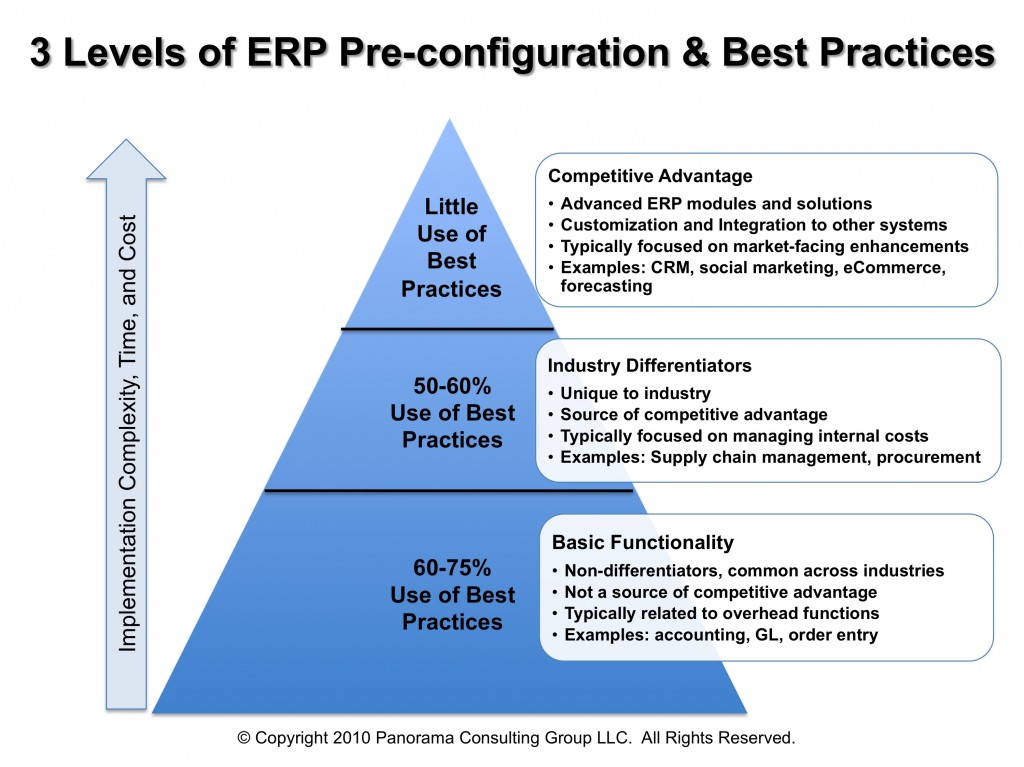Are ERP Best Practices Hurting Your E-Commerce Business?
Back in ’96 ERP systems quickly gained popularity among brick and mortar retailers who needed an all-encompassing solution to manage their data and increase efficiencies across business departments. The introduction of the ERP system brought about more collaboration, standardization, automation, and integration to all different business applications. However, the ERP system came with tradeoffs.
System integrations improved understanding across users but hindered flexibility. Data integration improved accuracy and reduced duplication of data but made it harder to correct. Implementing best practices improved operations through efficiency, but in the end, gave businesses less freedom and creativity to distinguish themselves from every other business. Even though ERP systems have improved in these areas, retailers are spending an outrageous fortune (average of $7.1 million just for ERP implementation) only to be left with an over-budget, pro-longed project that needs upgrades and maintenance every year. Thomas Wailgum, a writer at ASUG News, reveals the all-too familiar experience of many retailers undergoing an ERP implementation: “When durations stretch and scope increases, it can be tempting to stop working towards goals established in the beginning of the initiative or to change the definition of success as ‘getting the system up and running.'”
According to the 2013 ERP Report, researched and written by Panorama, a leading ERP consulting solution..
- The average project duration increased from 16 months to 17.8 months (year over year), the highest it’s been since 2009.
- More than half of ERP implementations exceeded their anticipated budget
- 61% exceeded their anticipated timeline
- 60% of retailers received 50% or less of the benefits they expected
- More than one quarter of respondents said “their organizations have not recouped the costs of their ERP software implementation”
- The average cost of the ERP system can be anywhere from $5 million to over $100 million depending on how big your business is and the number of users and the level of access each of these users will require from the system
For Internet retailers selling from a web store and/or marketplace, a big, single-system ERP deployment does not always make sense. In some situations an ERP will not help retailers make better use or sense of business data because they require unique tools to support customer relationships and decision-making among employees. E-Retailers are focusing more on high-value activities rather than on massive, full-blown and global ERP implementations. These high-value activities consist of product management, order management, and customer management across shopping carts, marketplaces, and offline. Integrating an ERP with online sales channels is not simple, making the process of managing those areas of the business time-consuming, expensive and complex.
For example, as a multi-channel retailer, you may use Microsoft Dynamics to consolidate inventory and adjust stock levels, but you must create your own programming to process inventory information from your online store and invest in a third party vendor to manage inventory from your marketplaces (Amazon & eBay), which you then have to integrate back into Microsoft Dynamics to consolidate and track all of those inventory updates. That’s three different systems essentially performing the same function.
 With a software solution such as SalesWarp, multi-channel retailers can utilize warehouse, purchasing, inventory and fulfillment functionality, all from one system, without a yearlong investment of time, money and resources. They also receive the tools they need to increase performance on the front-end. SalesWarp product management capabilities pull, configure and map specific product attributes to the requirements of everywhere retailers sell online. The synchronization of all the systems critical to an internet retailer delivers the software benefits a traditional ERP sought to deliver (collaboration, integration, automation) without the associated constraints.
With a software solution such as SalesWarp, multi-channel retailers can utilize warehouse, purchasing, inventory and fulfillment functionality, all from one system, without a yearlong investment of time, money and resources. They also receive the tools they need to increase performance on the front-end. SalesWarp product management capabilities pull, configure and map specific product attributes to the requirements of everywhere retailers sell online. The synchronization of all the systems critical to an internet retailer delivers the software benefits a traditional ERP sought to deliver (collaboration, integration, automation) without the associated constraints.
Retailers receive an immediate benefit with SalesWarp (implementation typically takes 6-8 weeks) at a lower cost than a traditional investment in an ERP, all while giving them the flexibility to leverage other enterprise software they already have in place, such as shopping cart, finance, CRM, or Human Resource applications. The modern architecture and integration capabilities of SalesWarp are becoming top priorities of fast-growing internet retailers.
There are also a few options retailers may consider when determining what they should utilize in replacement of an ERP system. When evaluating alternatives such as a SaaS ERP solution, you will find a lack of flexibility, security, and opportunity for growth. A commercial source code, like SalesWarp, gives retailers the flexibility to customize attributes and create workflows unique to each business. SalesWarp allows an unlimited number of users so retailers are not constrained by cost to restrict access or level of access to employees. This also gives retailers the flexibility to provide vendors access for the purposes of adding products, pulling orders and tracking fulfillment from the same system. Security is managed by tracking user activity and installing it on your own server reduces the risk of losing critical data. There are also opportunities for growth with SalesWarp. The ability to scale and adapt to an escalating amount of SKUs and orders allows the retailer to grow without encountering roadblocks from product/order thresholds or exuberant revenue based fees.
If you have any questions about ERP for eCommerce, feel free to reach out to us.
